Open air dancing
| Open air dancing | ||||
|---|---|---|---|---|
| In the national inventory | ||||
|
Practitioners and people who know the tradition well
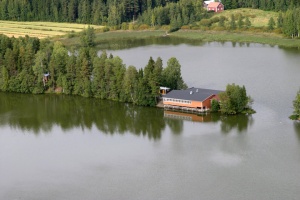
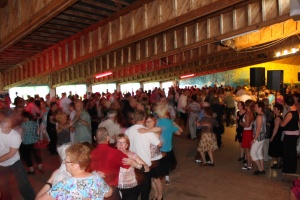
Open air dancing refers to events for partner dances organised on open air dance floors specifically built for this purpose, usually outside urban areas. Finland has long traditions of open air dancing, which remains popular among the general public. In a survey carried out by Taloustutkimus in 1991, 37% of the respondents reported that they planned to attend an open air dance during the summer. In relation to the population size of the time, this meant 1.85 million people. Midsummer Eve is the busiest night, and for some of the dancers, it is the only visit of the summer. The most enthusiastic dancers go dancing three times a week or even more often during the summer season and their dance trips can cover several regions.
Some of the dancers improve their dancing skills by taking part in courses and many dance venues offer a complementary dance course before the dance event begins. In addition to the dance schools, about 50 different ballroom dance clubs hold dancing courses. Training to become a ballroom dance teacher is offered to bachelor’s degree level, and the field of the teaching profession is extensive, ranging from dance instructors to teachers with different qualifications.
In the 20th century, most dance organisers were non-profit organisations, such as youth or sport associations and volunteer fire brigades, and people did plenty of communal work. Today, many dance venues have commercial objectives and hired staff, but the role of communal work is still large.
However, the most vital role is that of the musicians who provide the dance tempo. In small venues, performers can be duos or even one-man bands. The larger venues usually have at least one nationally known performer who has specialised in ballroom dance music. If an orchestra plays alone, they usually play for 45 minutes and have a break of 15 minutes. Often the venues have two bands, however, which means that live music is played throughout the entire evening. Today, instrumental music alone is not enough and the public would like for at least some of the songs to also be sung. The band may have one member who focuses on singing alone or one or more band members singing while also playing their instruments.
Practising of the tradition
There are over 300 dance pavilions and venues in regular use in Finland and, annually, nearly 5,000 dance events are held in these venues. Private events are also organised. The summer season is busier than the winter season: about three times as many dances are held in July than in January.
In some venues, dances are held all summer, even several times a week, but in some only one dance event is held. The number of open air dancefloors has decreased but their average size has continued to grow. In the 1940s, the surface area of an average dancefloor was 100 m². In the 1990s, a 250 m² dancefloor was considered small and a floor of up to 400 m² in size was nothing out of the ordinary. Thus, some of the development has featured a more centralised form of the tradition rather than actual diminishing of dance activity.
There are about 15 rhythms played or danced: foxtrot, tango, waltz, slow waltz, traditional Finnish partner dances humppa and jenkka, polka, mazurka, hambo, jive, single-time swing, bugg, samba, rhumba, cha-cha-cha and salsa. The music (dance rhythm) does not unequivocally determine the dance style, as some dance rhythms can be danced in several different ways. Dance styles that do not have their own rhythm but are still danced every night are single-time swing and bugg. The band can also play some songs that do not clearly represent any of the dance styles, allowing the dancers to improvise their steps more freely.
The current dance styles have international roots, but over the decades, national adaptations of them have developed. In the 20th century, certain differences could be observed even between the different regions, but as the dancers have started to move around more, these differences have disappeared. One of the most important dance styles for the dancers is the Finnish tango, through which the dancers can experience deep emotions, both from the perspective of movement and their emotional state. Single-time swing and foxtrot can also be considered unique Finnish dances, as their dance style is different from that danced elsewhere. The polka also features nationally unique aspects and inspires both the players and the dancers to greater and greater speeds. In the end, the dance becomes so quick that there is no time for the actual steps, but legs merely touch the floor and bounce up again like rubber balls. In addition to polka, humppa, jenkka and mazurka are also clearly Finnish dances. The dance events also feature dance styles that have kept their original style, such as slow waltz, cha-cha-cha, rhumba, samba and jive.
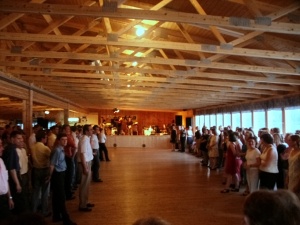
The open air dancefloors have their own etiquette, which aims to ensure that the dance events are pleasant for all parties.
On the dancefloor, the dancers arrange themselves so that women and men stand in separate lines. A sign or a light shows which gender is supposed to ask the other to dance. This turn may change at the beginning of every hour or one gender may be in charge of the asking for most of the evening. The dancefloor is circled anti-clockwise and (depending on the structure of the pavilion), stationary dances are usually danced in the centre of the dancefloor. The man usually leads the dance while the woman follows.
The band is expected to play two consecutive songs of the same dance style, which are danced with the same partner. After this, both partners thank each other for the dance, the man returns the woman to her place in the line and both thank each other again. The dance event is usually started and ended with a waltz, but otherwise the performers are free to choose the order of the dance styles. A few dance venues stick to the rule that certain dance styles are played during every dance event and recorded music is played, if necessary for this.
The background and history of the tradition
Before the mid 19th century, dances were held in large houses, drying barns, on roads and bridges. If there were no suitable places, any even rock, sand or grass surface would do.
Open air dancefloors have been mentioned in newspapers since 1879. According to Rauma newspaper, in 1893 the dancefloors were everywhere, to the dismay of the writer. Anti-dance protestors did not settle for mere verbal arguments: the open air dancefloors were demolished, rebuilt and demolished again. However, others were more understanding of the dance enthusiasm of young people and some homeowners built dancefloors on their private land, and people did not dare to destroy them, at least not publicly.
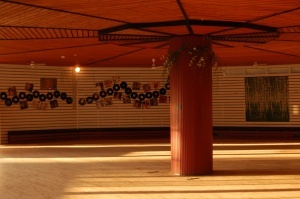
In the 1940s, most built open air dancefloors were still simple, about 10x10 metre outdoor platforms. Their service life was usually only a few years. Larger, decked dancefloors replaced the outdoor platforms in the 1950s. In other ways, as well, the 1950s were the golden era of ballroom dancing and many of the venues from that decade are still in use. A popular design was an octagonal dancefloor that was supported by one sturdy central pillar. The dancefloor’s size was typically little over 200 m².
Estimates about the number of open air dancefloors vary. In the collection competition by the National Board of Antiquities in 1991, over 800 named summer dancefloors were found, but one dancefloor could have several names and not all of them were in operation at the same time.
The state had a negative stand on outdoor dances and it attempted to control them through a so-called entertainment tax. The tax came into force in 1914 and was applied up until 1981. At its most expensive, the tax was 50% of the ticket price. The tax was avoided by selling the same tickets twice or by not giving the tax form to friends and other trustworthy people. People could also pretend that the event was a soiree, because it was permitted to have a one-hour tax-free dance after a soiree. If the police happened to come, the dancing was interrupted and someone started a speech.
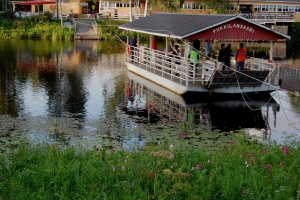
Reportedly, Finland was the only country in the world that prohibited dance during World War II. The first prohibition was ordered in the beginning of the Winter War. During the Interim Peace, dancing was allowed again, but when the Continuation War started, the prohibition came back into force and remained in force for over three years.
The dance prohibition was evaded and violated. According to a story recorded in Kauhajoki, the dancefloor was brought to the location in pieces, assembled at the beginning of the dance and disassembled afterwards. In Helsinki, dances were held under the guise of dance courses, but in 1943 these, too, were defined as public entertainment events, if new students were accepted during the course or if more than half an hour was danced together in a day. Private home parties with too many guests were also interrupted. At weddings, the couple were allowed to dance one waltz, but the guests were only allowed to watch.
Violating the prohibition could result in fines or even imprisonment. The dancers had their own counter measures: a guard was positioned outside the venue, and when the police came, the guests would disperse. More cunning people set up a show for the police: when they arrived, the men and the women separated and stood on different sides of the pavilion and a soloist started to perform alone. After the police left, the dance would continue. However, there was a good reason to be afraid of the police raids: in 1944 one person was fatally shot by police when the dancers attempted to escape a raid.
The open air dancefloor culture withstood pressure from above, but in the 1960s and the 1970s it faced a crisis as new, competing recreational activities and new popular music started to emerge rapidly. For a while, the venues attempted to hold events that offered something for everyone: one band played traditional ballroom dance music and the other popular schlager music for the younger generation. This concept did not work very well and many venues had to close their doors. The wind changed again in the 1980s, and attitude towards ballroom dancing became more positive. This newfound popularity and the visibility of the culture to the larger public were facilitated, in particular, by Lappeenranta Humppa dance festival in 1977–1988 and Seinäjoen Tangomarkkinat Tango festival, which was established in 1985. Dance teaching has become notably more diverse and ballroom dance teachers are trained at Universities of Applied Sciences.
The transmission of the tradition
Up until the late 20th century, it was common for friends and family to teach people to dance. However, today dance studios and schools, open air dance clubs and associations have a much more important role in passing on the tradition. Dance schools and associations focusing on partner dances offer dance teaching through various dance courses. In addition to this, associations offer their members dance trips to open air dancefloors all over Finland, as well as dance cruises and other activities related to partner dances.
The elements of dance are also to large extent passed on from one dancer to another, although this happens in such an unnoticeable manner that the dancers may not even be aware of it.
The tradition is both passed on and developed by training dance instructors and teachers. Instructors for the association activities are trained at the ballroom dancing instructor courses of Suomen Seuratanssiliitto SUSEL ry and at the courses arranged by a few private parties. A ballroom dancing division operates under the Suomen Tanssinopettajain Liitto STOL ry (Finnish dance teachers’ association) and membership can be applied for after receiving a degree. Partner dance teacher education at bachelor’s degree level is offered, reportedly as the only place in the world, at Oulu University of Applied Sciences. The scope of the degree is 240 academic credits.
Another indication of the cultural strength of the open air dance tradition is that in many places Finns living abroad have established communities that come together for Suomi dances, i.e. open air dancing. These events take place, for example, in Los Angeles, Florida, Australia, Tenerife, Gothenburg and Eskilstuna. Thus, open air dancing, for its part, reinforces the uniquely Finnish cultural identity of Finns living abroad.
For the ‘general public’ that does not attend open air dances, the dance events have an outdated image; they are seen as events for ‘seniors getting their jive on’. Despite this, open air dances continue to attract people of all ages, young people included, and the dancers who have fallen in love with this culture have noticed that the open air dance culture is a lively culture, to which people are attracted thanks to the joy of shared musical movement as well as the joyful and social nature of the events. Many enthusiasts feel that one specifically valuable aspect of the dance events is that alcohol takes a clear back seat during these evenings, especially compared to the past.
The etiquette of the open air dances is passed on in many ways: many open air dancefloors have a special sign that explains the specific rules of the venue to the dancers attending. Structurally, the dance pavilions differ from each other, and the rules attempt to explain which places on the dancefloor are reserved for stationary dancing and which for onward-moving dancing in order to prevent any disturbances to other dancers. The dance etiquette is also passed on as oral history from one dance enthusiast to another. Some applicable parts of the dance etiquette (such as taking other dancing couples into account) are also taught at dance courses.
The future of the tradition
Perhaps the most significant change concerning dance culture has taken place in peoples’ attitudes. As late as in the 1990s, open air dancing was often mocked, especially in cities. The consumption of alcohol has undergone a very radical change. Many old dance venues also featured a cell for holding drunken troublemakers, but these days drunken behaviour is a rare sight on the dancefloors. In part, this change has certainly helped develop the positive image of open air dancing, and today, the dances are also seen as social, sporty events that promote health. The television show ‘Dancing with the stars’ has, in general, increased people’s interest in dance, even though the show does not feature open air dancing.
Open air dances not only preserve the tradition, they also continually reshape it. In the 21st century, many new dance styles have been introduced to open air dances. Foxtrot has been partly replaced by single-time swing, walking humppa steps have taken over closing step humppa, the Bugg dance style has been imported from Sweden and has become very popular, and swing polka has emerged as a variation of standard polka. In addition to this, separate dance genres have emerged in cities, in particular, attracting young people especially to the world of partner dancing – and some of them end up coming to the open air dances, too.
The open air dance etiquette is also transforming: as gender equality is emphasised in society, this also is reflected in the dance etiquette, and in many places, there are no turns for men and women to ask each other to dance, but instead anyone can ask others to dance during the whole evening.
The possible change of the age profile of avid open air dancers has not been studied, but the gradual aging of dance enthusiasts could be a threat to this culture. On the other hand, new active dancers keep finding open air dances, especially through various dance courses.
The communities behind this submission.
Suomen Tanssinopettajain Liitto STOL ry
Suomen Seuratanssiliitto SUSEL ry
Suomen tanssipalvelin tanssi.net
Oamk / Tanssinopettajan tutkinto-ohjelma
Matti Jokinen
Petri Riihikallio
Bibliography and links to external sources of information
More information
Suomen Tanssistudiot Oy: The ABC of dance, history, background and instructions
Links
Keisala, Jyrki: Suomalaisen seuratanssin lyhyt historia
Bibliography
Hakulinen Kerkko & Yli-Jokipii Pentti: Tanssilavakirja. AtlasArt 2007, ISBN 978-952-5671-07-0.
Hirvonen Marianne: Lavatanssit Raisiossa 1950-luvun alusta nykypäivään. Pro gradu, kansatiede, maaliskuu 2001, 75 s.
Jalkanen Pekka & Kurkela Vesa: Suomen Musiikin Historia, Populaarimusiikki. WS Bookwell Oy, Porvoo 2003, ISBN 951-0-27706-1.
Jokinen Matti: Tanssipaikkaopas. 1993, 1995, 1997, 2001, viimeisimmän ISBN 951-97210-2-9.
Kahila Heikki ja Pia: Kun Suomi sanoi Saanko luvan, Gummerus Kustannus Oy, Jyväskylä 2006, ISBN 951-20-6767-6.
Laine Juha: Suomalaisten nuorten tanssilavakulttuuri - modernia kansankulttuuria? Pro gradu, Jyväskylän yliopisto 2003. Linkki julkaisuun.
Niemelä Veikko: Paritanssin pyörteitä vuodesta 1650 vuoteen 1995.
Nieminen Aila: Tanssilava, järvi ja hanuri. Lavatanssit Suomessa vuosisadan vaihteesta 1960-luvun loppuun asti. Pro gradu, Jyväskylän yliopiston etnologian laitos.
Pesola Sakari: Tanssikiellosta lavatansseihin, teoksessa Rillumarei ja valistus (toim. Matti Peltonen), s. 105--126. Historiallinen arkisto 108, Suomen historiallinen seura, Helsinki 1996.
Talve Ilmari: Suomalainen kansankulttuuri, Mikkeli 1980.
Yli-Jokipii Pentti: Paikallisyhteisöjen muutos Suomessa kesäisten tanssilavojen kuvastamana.
Yli-Jokipii Pentti: The Cultural Geography of the Summer Dance Pavillions of Ostrobothnia, Finland. Journal of Cultural Geography 18 (1999), 109--132.
